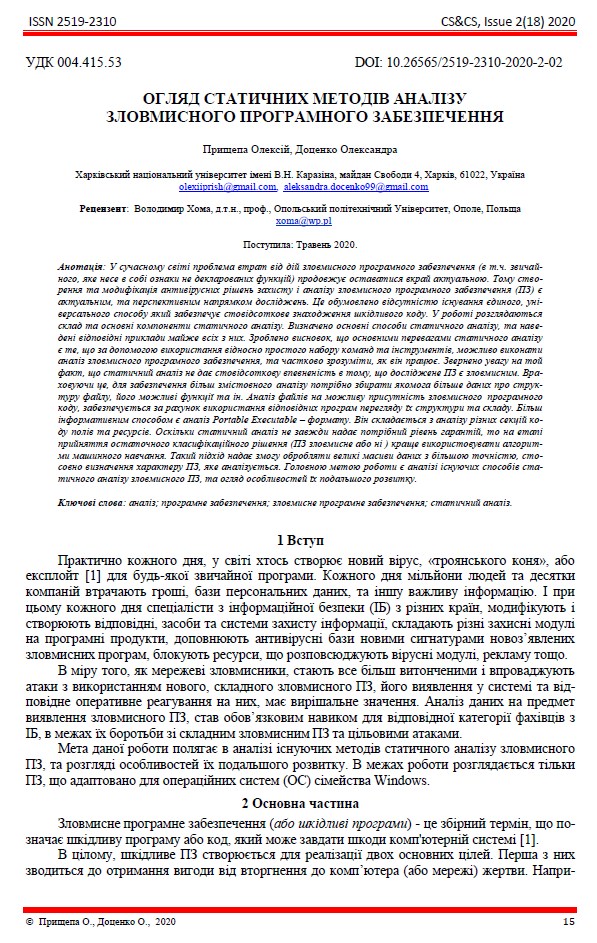Огляд статичних методів аналізу зловмисного програмного забезпечення
Анотація
У сучасному світі проблема втрат від дій зловмисного програмного забезпечення (в т.ч. звичайного, яке несе в собі ознаки не декларованих функцій) продовжує оставатися вкрай актуальною. Тому створення та модифікація антивірусних рішень захисту і аналізу зловмисного програмного забезпечення (ПЗ) є актуальним, та перспективним напрямком досліджень. Це обумовлено відсутністю існування єдиного, універсального способу який забезпечує стовідсоткове знаходження шкідливого коду. У роботі розглядаються склад та основні компоненти статичного аналізу. Визначено основні способи статичного аналізу, та наведені відповідні приклади майже всіх з них. Зроблено висновок, що основними перевагами статичного аналізу є те, що за допомогою використання відносно простого набору команд та інструментів, можливо виконати аналіз зловмисного програмного забезпечення, та частково зрозуміти, як він працює. Звернено увагу на той факт, що статичний аналіз не дає стовідсоткову впевненість в тому, що досліджене ПЗ є зловмисним. Враховуючи це, для забезпечення більш змістовного аналізу потрібно збирати якомога більше даних про структуру файлу, його можливі функції та ін. Аналіз файлів на можливу присутність зловмисного програмного коду, забезпечується за рахунок використання відповідних програм перегляду їх структури та складу. Більш інформативним способом є аналіз Portable Executable – формату. Він складається з аналізу різних секцій коду полів та ресурсів. Оскільки статичний аналіз не завжди надає потрібний рівень гарантій, то на етапі прийняття остаточного класифікаційного рішення (ПЗ зловмисне або ні ) краще використовувати алгоритми машинного навчання. Такий підхід надає змогу обробляти великі масиви даних з більшою точністю, стосовно визначення характеру ПЗ, яке аналізується. Головною метою роботи є аналізі існуючих способів статичного аналізу зловмисного ПЗ, та огляд особливостей їх подальшого розвитку.
Завантаження
Посилання
Вредоносное ПО [Електронний ресурс] / Malwarebytes Режим доступу до ресурсу: https://ru.malwarebytes.com/malware/ (дата звернення 19.05.2020) - Загл. с экрана
Вредоносные программы (malvare) [Електронний ресурс] / Anti-Malware. Режим доступу до ресурсу: https://www.anti-malware.ru/threats/malware (дата звернення 19.05.2020) - Загл. с экрана
Michael S. Practical Malware Analysis: The Hands – On Guide to Dissecting Malicious Software / Michael S., Andrew H.; пер. с англ. Черников С. – Санкт-Питербург : Питер, 2018. - 786 с. (Серия «Для профессионалов»).
Монаппа К. А. Анализ вредоносных программ / пер. с анг. Д. А. Беликова. – М.: ДМК Пресс, 2019. – 452 с.: ил.
VirusTotal Доступ до електронного ресурсу: https://www.virustotal.com/gui/
Peering Inside the PE: A Tour of the Win32 Portable Executable File Format [Електронний ресурс] / Pietrek M. // Microsoft Docs. - 2010 Доступ до електронного ресурсу: https://docs.microsoft.com/en-us/previous-versions/ms809762(v=msdn.10)-?redirectedfrom=MSDN (дата звернення 11.05.2020) - Загл. с экрана
Борьба с вирусами: опыт контртеррористических операций / Касперски К. // Системный администратор. – 2004. – Режим доступу до журн.: http://citforum.ru/security/virus/virii_dis/ (дата звернення 18.05.2020) - Загл. с экрана


